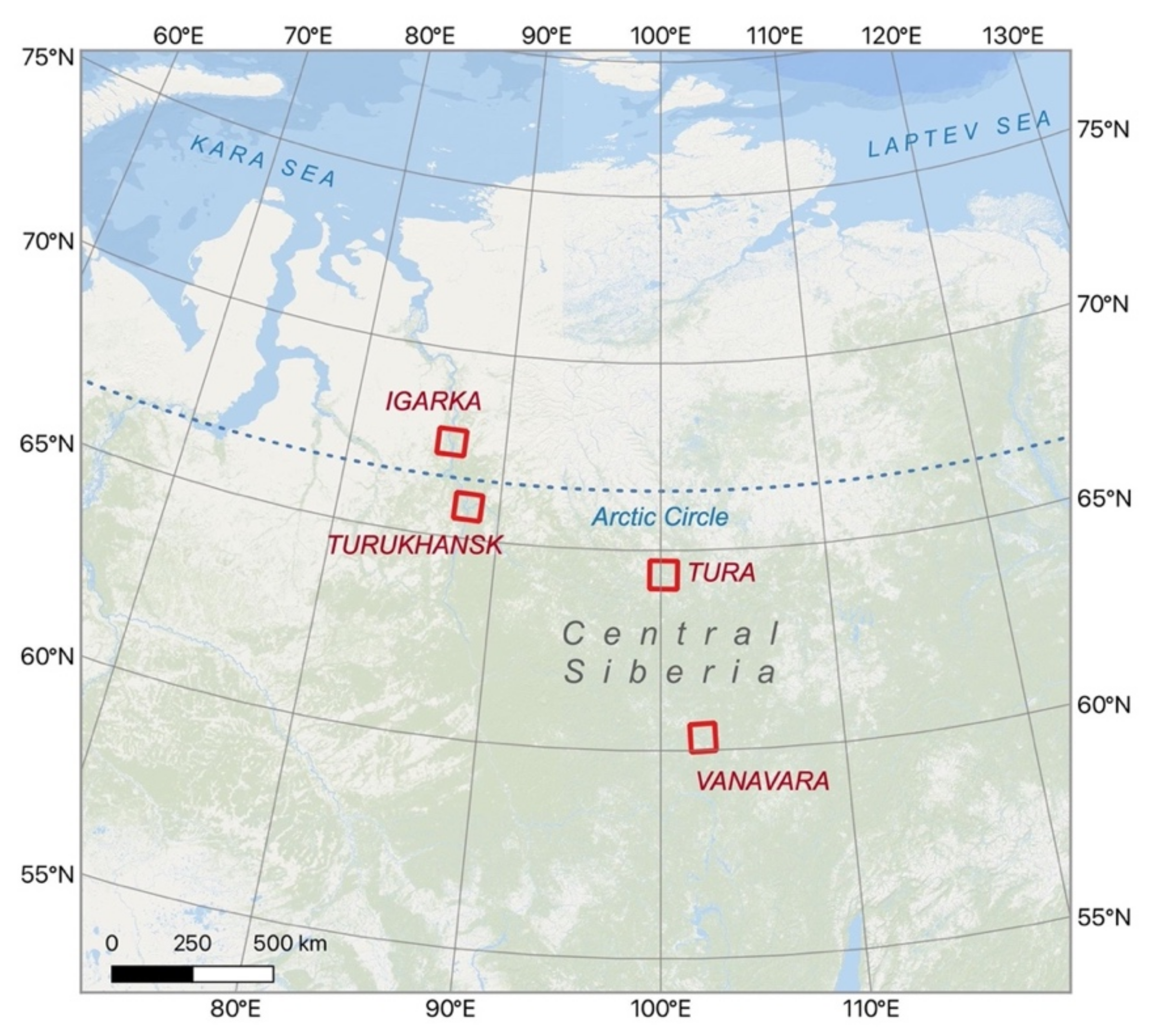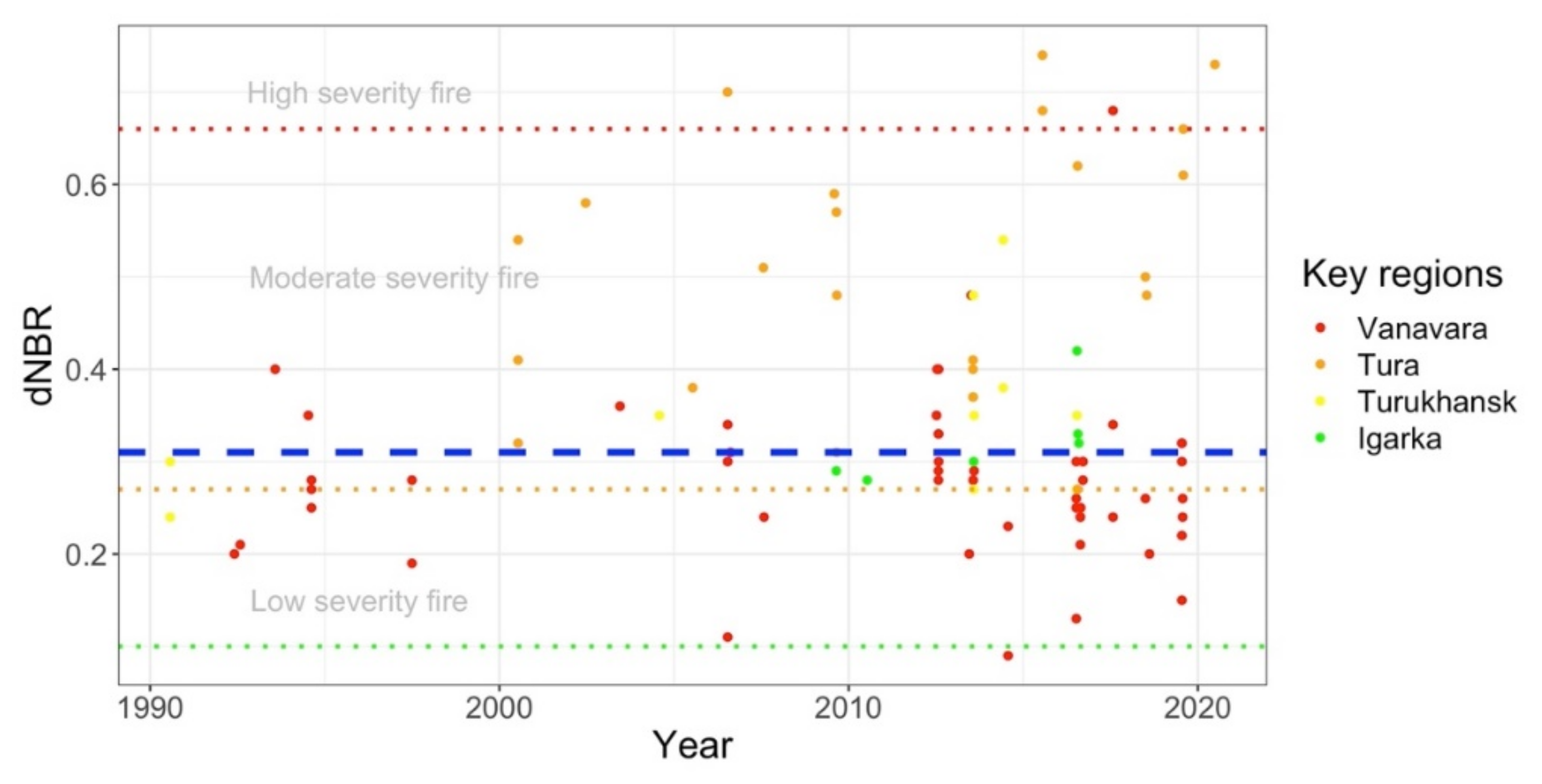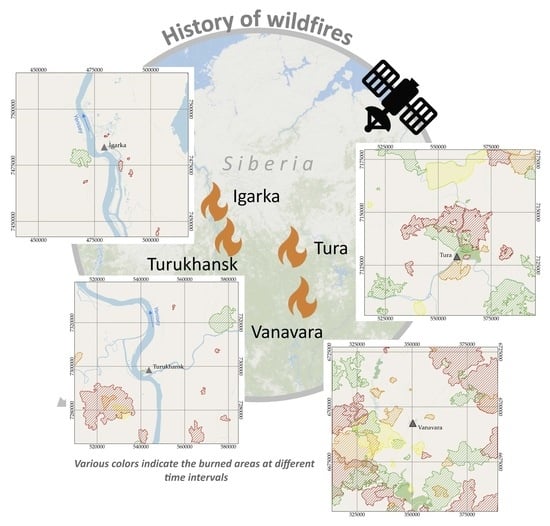Wildfire Dynamics along a North-Central Siberian Latitudinal Transect Assessed Using Landsat Imagery
Abstract
:1. Introduction
2. Materials and Methods
2.1. Description of Key Regions
2.2. Satellite Data Pre-Processing
2.3. Burned Area Mapping
2.4. Fire Severity and Vegetation Recovery
2.5. Statistical Processing
3. Results
3.1. Wildfire History along the North-Central Siberian Latitudinal Transect
3.1.1. Vanavara Region
3.1.2. Tura Region
3.1.3. Turukhansk Region
3.1.4. Igarka Region
3.2. Temporal Dynamics of NDVI, NBR and Fire Severity
4. Discussion
4.1. History of Wildfires in North-Central Siberia Regions
4.2. Post-Fire Vegetation Recovery and Fire Severity
5. Conclusions
Author Contributions
Funding
Data Availability Statement
Acknowledgments
Conflicts of Interest
References
- Bond, W.J.; Keeley, J.E. Fire as a global “herbivore”: The ecology and evolution of flammable ecosystems. Trends Ecol. Evol. 2005, 20, 387–394. [Google Scholar] [CrossRef] [PubMed]
- IPCC. IPCC Special Report on the Ocean and Cryosphere in a Changing Climate; IPCC: Geneva, Switzerland, 2019. [Google Scholar]
- Soja, A.; Tchebakova, N.M.; French, N.H.F.; Flannigan, M.D.; Shugart, H.H.; Stocks, B.J.; Sukhinin, A.I.; Parfenova, E.I.; Chapin, F.S.I.; Stackhouse, P.W., Jr. Climate-induced boreal forest change: Predictions versus current observations. Glob. Planet. Change 2007, 56, 274–296. [Google Scholar] [CrossRef] [Green Version]
- Goetz, S.J.; Mack, M.C.; Gurney, K.R.; Randerson, J.T.; Houghton, R.A. Ecosystem responses to recent climate change and fire disturbance at northern high latitudes: Observations and model results contrasting northern Eurasia and North America. Environ. Res. Lett. 2007, 2, 45031. [Google Scholar] [CrossRef]
- Kukavskaya, E.A.; Buryak, L.V.; Shvetsov, E.G.; Conard, S.G.; Kalenskaya, O.P. The impact of increasing fire frequency on forest transformations in southern Siberia. For. Ecol. Manag. 2016, 382, 225–235. [Google Scholar] [CrossRef]
- Chu, T.; Guo, X.; Takeda, K. Effects of Burn Severity and Environmental Conditions on Post-Fire Regeneration in Siberian Larch Forest. Forests 2017, 8, 76. [Google Scholar] [CrossRef]
- Kirdyanov, A.V.; Saurer, M.; Siegwolf, R.; Knorre, A.A.; Prokushkin, A.S.; Churakova, O.V.; Fonti, M.V.; Büntgen, U. Long-term ecological consequences of forest fires in the continuous permafrost zone of Siberia. Environ. Res. Lett. 2020, 15, 34061. [Google Scholar] [CrossRef]
- Groisman, P.Y.; Gutman, G. (Eds.) Climate Changes in Siberia. In Regional Environmental Changes in Siberia and Their Global Consequences; Springer: Dordrecht, The Netherlands, 2012; pp. 57–109. [Google Scholar]
- Vivchar, A. Wildfires in Russia in 2000–2008: Estimates of burnt areas using the satellite MODIS MCD45 data. Remote Sens. Lett. 2011, 2, 81–90. [Google Scholar] [CrossRef]
- Kukavskaya, E.A.; Soja, A.J.; Petkov, A.P.; Ponomarev, E.I.; Ivanova, G.A.; Conard, S.G. Fire emissions estimates in siberia: Evaluation of uncertainties in area burned, land cover, and fuel consumption. Can. J. For. Res. 2013, 43, 493–506. [Google Scholar] [CrossRef]
- Shvidenko, A.Z.; Shchepashchenko, D.G.; Vaganov, E.A.; Sukhinin, A.I.; Maksyutov, S.S.; McCallum, I.; Lakyda, I.P. Impact of wildfire in Russia between 1998-2010 on ecosystems and the global carbon budget. Dokl. Earth Sci. 2011, 441, 1678–1682. [Google Scholar] [CrossRef]
- Miller, J.D.; Skinner, C.; Safford, H.D.; Knapp, E.E.; Ramirez, C.M. Trends and causes of severity, size, and number of fires in northwestern California, USA. Ecol. Appl. 2012, 22, 184–203. [Google Scholar] [CrossRef]
- Guindon, L.; Gauthier, S.; Manka, F.; Parisien, M.-A.; Whitman, E.; Bernier, P.; Beaudoin, A.; Villemaire, P.; Skakun, R. Trends in wildfire burn severity across Canada, 1985 to 2015. Can. J. For. Res. 2020, 51, 1230–1244. [Google Scholar] [CrossRef]
- Leskinen, P.; Lindner, M.; Verkerk, P.J.; Nabuurs, G.J.; Van Brusselen, J.; Kulikova, E.; Hassegawa, M.; Lerink, B. Russian Forests and Climate Change: What Science Can Tell Us 11; European Forest Institute: Joensuu, Finland, 2020. [Google Scholar]
- Jin, Y.; Randerson, J.T.; Goulden, M.L.; Goetz, S.J. Post-fire changes in net shortwave radiation along a latitudinal gradient in boreal North America. Geophys. Res. Lett. 2012, 39, 13403. [Google Scholar] [CrossRef] [Green Version]
- Amiro, B.D.; Todd, J.B.; Wotton, B.M.; Logan, K.A.; Flannigan, M.D.; Stocks, B.J.; Mason, J.A.; Martell, D.L.; Hirsch, K.G. Direct carbon emissions from Canadian forest fires, 1959–1999. Can. J. For. Res. 2001, 31, 512–525. [Google Scholar] [CrossRef]
- Liu, Y.; Goodrick, S.; Heilman, W.E. Wildland fire emissions, carbon, and climate: Wildfire–Climate interactions. For. Ecol. Manag. 2014, 317, 80–96. [Google Scholar] [CrossRef]
- Kirsanov, A.; Rozinkina, I.; Rivin, G.; Zakharchenko, D.; Olchev, A. Effect of natural forest fires on regional weather conditions in Siberia. Atmosphere 2020, 11, 1133. [Google Scholar] [CrossRef]
- Sukhinin, A.I.; French, N.H.F.; Kasischke, E.S.; Hewson, J.H.; Soja, A.J.; Csiszar, I.A.; Hyer, E.J.; Loboda, T.; Conrad, S.G.; Romasko, V.I.; et al. AVHRR-based mapping of fires in Russia: New products for fire management and carbon cycle studies. Remote Sens. Environ. 2004, 93, 546–564. [Google Scholar] [CrossRef]
- Berner, L.T.; Beck, P.S.A.; Loranty, M.M.; Alexander, H.D.; Mack, M.C.; Goetz, S.J. Cajander larch (Larix cajanderi) biomass distribution, fire regime and post-fire recovery in northeastern Siberia. Biogeosciences 2012, 9, 3943–3959. [Google Scholar] [CrossRef] [Green Version]
- Bartalev, S.A.; Egorov, V.A.; Efremov, V.Y.; Lupyan, E.A.; Stytsenko, F.V.; Flitman, E.V. Evaluation of fire area based on Modis and Landsat-TM/ETM satellite data integration with different spatial resolution. Sovremennye Problemy Distantsionnogo Zondirovania Zemli iz Kosmosa 2012, 9, 9–26. [Google Scholar]
- Gorelick, N.; Hancher, M.; Dixon, M.; Ilyushchenko, S.; Thau, D.; Moore, R. Google Earth Engine: Planetary-scale geospatial analysis for everyone. Remote Sens. Environ. 2017, 202, 18–27. [Google Scholar] [CrossRef]
- Novenko, E.Y.; Kupryanov, D.A.; Mazei, N.G.; Prokushkin, A.S.; Phelps, L.N.; Buri, A.; Davis, B.A.S. Evidence that modern fires may be unprecedented during the last 3400 years in permafrost zone of Central Siberia, Russia. Environ. Res. Lett. 2022, 7, 25004. [Google Scholar] [CrossRef]
- Novenko, E.Y.; Rudenko, O.V.; Mazei, N.G.; Kupriyanov, D.A.; Batalova, V.A.; Volkova, E.M.; Phelps, L.N.; Davis, B.A.S. Late-Holocene vegetation and fire history in Western Putorana Plateau (subarctic Siberia, Russia). Holocene 2022. [Google Scholar] [CrossRef]
- Beck, H.E.; Zimmermann, N.E.; McVicar, T.R.; Vergopolan, N.; Berg, A.; Wood, E.F. Present and future Köppen-Geiger climate classification maps at 1-km resolution. Sci. Data 2018, 5, 180214. [Google Scholar] [CrossRef] [PubMed] [Green Version]
- Sokolov, V.A.; Farber, S.K. Reforestation in the Eastern Siberia Forests; Siberian Branch of Russian Academy of Sciences: Novosibirsk, Russia, 2006. [Google Scholar]
- Sofronov, M.A.; Volokitina, A.V. Wildfire ecology in continuous permafrost zone. In Permafrost Ecosystems: Siberian Larch Forests; Osawa, A., Zyryanova, O.A., Matsuura, Y., Kajimoto, T., Wein, R.W., Eds.; Springer: Berlin/Heidelberg, Germany, 2010; pp. 59–82. [Google Scholar]
- Masek, J.G.; Vermote, E.F.; Saleous, N.E.; Wolfe, R.; Hall, F.G.; Huemmrich, K.F.; Gao, F.; Kutler, J.; Lim, T.-K. A Landsat surface reflectance dataset for North America. IEEE Geosci. Remote Sens. Lett. 2006, 3, 68–72. [Google Scholar] [CrossRef]
- Vermote, E.; Justice, C.; Claverie, M.; Franch, B. Preliminary analysis of the performance of the Landsat 8/OLI land surface reflectance product. Remote Sens. Environ. 2016, 185, 46–56. [Google Scholar] [CrossRef] [PubMed]
- Ponomarev, E.I.; Kharuk, V.I.; Ranson, K.J. Wildfires dynamics in Siberian larch forests. Forests 2016, 7, 125. [Google Scholar] [CrossRef] [Green Version]
- Hansen, M.C.; Potapov, P.V.; Moore, R.; Hancher, M.; Turubanova, S.A.; Tyukavina, A.; Thau, D.; Stehman, S.V.; Goetz, S.J.; Loveland, T.R.; et al. High-Resolution Global Maps of 21st-Century Forest Cover Change. Science 2013, 342, 850–853. [Google Scholar] [CrossRef] [Green Version]
- Key, C.H.; Benson, N.C. The Normalized Burn Ratio (NBR): A Landsat TM Radiometric Measure of Burn Severity; United States Geological Survey, Northern Rocky Mountain Science Center: Bozeman, MT, USA, 1999. [Google Scholar]
- Veraverbeke, S.; Lhermitte, S.; Verstraeten, W.; Goossens, R. Assessing burn severity using satellite time series. WIT Trans. Ecol. Environ. 2010, 137, 107–118. [Google Scholar] [CrossRef] [Green Version]
- Tucker, C.J. Red and photographic infrared linear combinations for monitoring vegetation. Remote Sens. Environ. 1979, 8, 127–150. [Google Scholar] [CrossRef] [Green Version]
- Xu, H. Modification of Normalised Difference Water Index (NDWI) to Enhance Open Water Features in Remotely Sensed Imagery. Int. J. Remote Sens. 2006, 27, 3025–3033. [Google Scholar] [CrossRef]
- Key, C.H.; Benson, N.C. Measuring and remote sensing of burn severity. In Proceedings of the Joint Fire Science Conference and Workshop: “Crossing the Millennium: Integrating Spatial Technologies and Ecological Principles for a New Age in Fire Management”, Boise, ID, USA, 15–17 June 1999; Neuenschwander, L.F., Ryan, K.C., Eds.; University of Idaho: Moscow, ID, USA; International Association of Wildland Fire: Fairfield, WA, USA, 2000; pp. 284–285. [Google Scholar]
- Mann, H.B. Nonparametric tests against trend. Econometrica 1945, 13, 245–259. [Google Scholar] [CrossRef]
- R Core Team. R: A Language and Environment for Statistical Computing; R Foundation for Statistical Computing: Vienna, Austria, 2021. [Google Scholar]
- Krylov, A.; McCarty, J.L.; Potapov, P.; Loboda, T.; Tyukavina, A.; Turubanova, S.; Hansen, M.C. Remote sensing estimates of stand-replacement fires in Russia, 2002–2011. Environ. Res. Lett. 2014, 9, 105007. [Google Scholar] [CrossRef]
- Kharuk, V.I.; Ponomarev, E.I. Spatiotemporal characteristics of wildfire frequency and relative area burned in larch-dominated forests of Central Siberia. Russ. J. Ecol. 2017, 48, 507–512. [Google Scholar] [CrossRef]
- Moskovchenko, D.V.; Arefyev, S.P.; Moskovchenko, M.D.; Yurtaev, A.A. Spatiotemporal Analysis of Wildfires in the Forest Tundra of Western Siberia. Contemp. Probl. Ecol. 2020, 13, 193–203. [Google Scholar] [CrossRef]
- Feurdean, A.; Florescu, G.; Tanţău, I.; Vannière, B.; Diaconu, A.-C.; Pfeiffer, M.; Warren, D.; Hutchinson, S.M.; Gorina, N.; Gałka, M.; et al. Recent fire regime in the southern boreal forests of western Siberia is unprecedented in the last five millennia. Quat. Sci. Rev. 2020, 244, 106495. [Google Scholar] [CrossRef]
- Knorre, A.; Kirdyanov, A.; Prokushkin, A.; Krusic, P.; Büntgen, U. Tree ring-based reconstruction of the long-term influence of wildfires on permafrost active layer dynamics in Central Siberia. Sci. Total Environ. 2019, 652, 314–319. [Google Scholar] [CrossRef] [Green Version]
- Casady, G.M.; Van Leeuwen, W.J.D.; Marsh, S.E. Evaluating Post-wildfire Vegetation Regeneration as a Response to Multiple Environmental Determinants. Environ. Model Assess. 2009, 15, 295–307. [Google Scholar] [CrossRef]
- Korets, M.A.; Ryzhkova, V.A.; Danilova, I.V.; Prokushkin, A.S. Vegetation cover mapping based on remote sensing and digital elevation model data. In Proceedings of the International Archives of the Photogrammetry, Remote Sensing and Spatial Information Sciences-ISPRS, Prague, Czech Republic, 12–19 July 2016; pp. 699–704. [Google Scholar]
- Sizov, O.S.; Ezhova, E.; Tsymbarovich, P.; Soromotin, A.; Prihod’ko, N.; Petäjä, T.; Zilitinkevich, S.; Kulmala, M.; Bäck, J.; Köster, K. Fire and vegetation dynamics in northwest Siberia during the last 60 years based on high-resolution remote sensing. Biogeosciences 2021, 18, 207–228. [Google Scholar] [CrossRef]
- Landhausser, S.M.; Wein, R.W. Postfire Vegetation Recovery and Tree Establishment at the Arctic Treeline: Climate-Change-Vegetation-Response Hypotheses. J. Ecol. 1993, 81, 665–672. [Google Scholar] [CrossRef]
- Mollicone, D.; Eva, H.D.; Achard, F. Human role in Russian wild fires. Nature 2006, 440, 436–437. [Google Scholar] [CrossRef]





| Key Regions | Region Locations | Vegetation Zone |
|---|---|---|
| Vanavara | 60.3–59.95°N, 101.6–103°E | middle taiga |
| Tura | 64.0–64.7°N, 99.3–101.1°E | northern taiga |
| Turukhansk | 65.5–66.2°N, 87.2–88.9°E | northern taiga |
| Igarka | 67.1–67.8°N, 85.6–87.4°E | forest–tundra |
| Time Interval | Vanavara | Tura | Turukhansk | Igarka |
|---|---|---|---|---|
| 1985–1995 | 4 July 1994 | 26 July 1995 * 21 July 1996 * | 29 August 1987 | 17 August 1986 |
| 1995–2005 | 4 July 2000 | 5 August 2001 | 16 August 1994 | 17 July 1998 |
| 2005–2015 | 24 July 2013 | 29 July 2007 20 July 2013 | 18 August 2009 | 23 August 2009 |
| 2015–2020 | 2 July 2020 | 30 July 2020 | 21 August 2019 | 18 July 2019 |
Publisher’s Note: MDPI stays neutral with regard to jurisdictional claims in published maps and institutional affiliations. |
© 2022 by the authors. Licensee MDPI, Basel, Switzerland. This article is an open access article distributed under the terms and conditions of the Creative Commons Attribution (CC BY) license (https://creativecommons.org/licenses/by/4.0/).
Share and Cite
Dvornikov, Y.; Novenko, E.; Korets, M.; Olchev, A. Wildfire Dynamics along a North-Central Siberian Latitudinal Transect Assessed Using Landsat Imagery. Remote Sens. 2022, 14, 790. https://doi.org/10.3390/rs14030790
Dvornikov Y, Novenko E, Korets M, Olchev A. Wildfire Dynamics along a North-Central Siberian Latitudinal Transect Assessed Using Landsat Imagery. Remote Sensing. 2022; 14(3):790. https://doi.org/10.3390/rs14030790
Chicago/Turabian StyleDvornikov, Yury, Elena Novenko, Mikhail Korets, and Alexander Olchev. 2022. "Wildfire Dynamics along a North-Central Siberian Latitudinal Transect Assessed Using Landsat Imagery" Remote Sensing 14, no. 3: 790. https://doi.org/10.3390/rs14030790
APA StyleDvornikov, Y., Novenko, E., Korets, M., & Olchev, A. (2022). Wildfire Dynamics along a North-Central Siberian Latitudinal Transect Assessed Using Landsat Imagery. Remote Sensing, 14(3), 790. https://doi.org/10.3390/rs14030790









